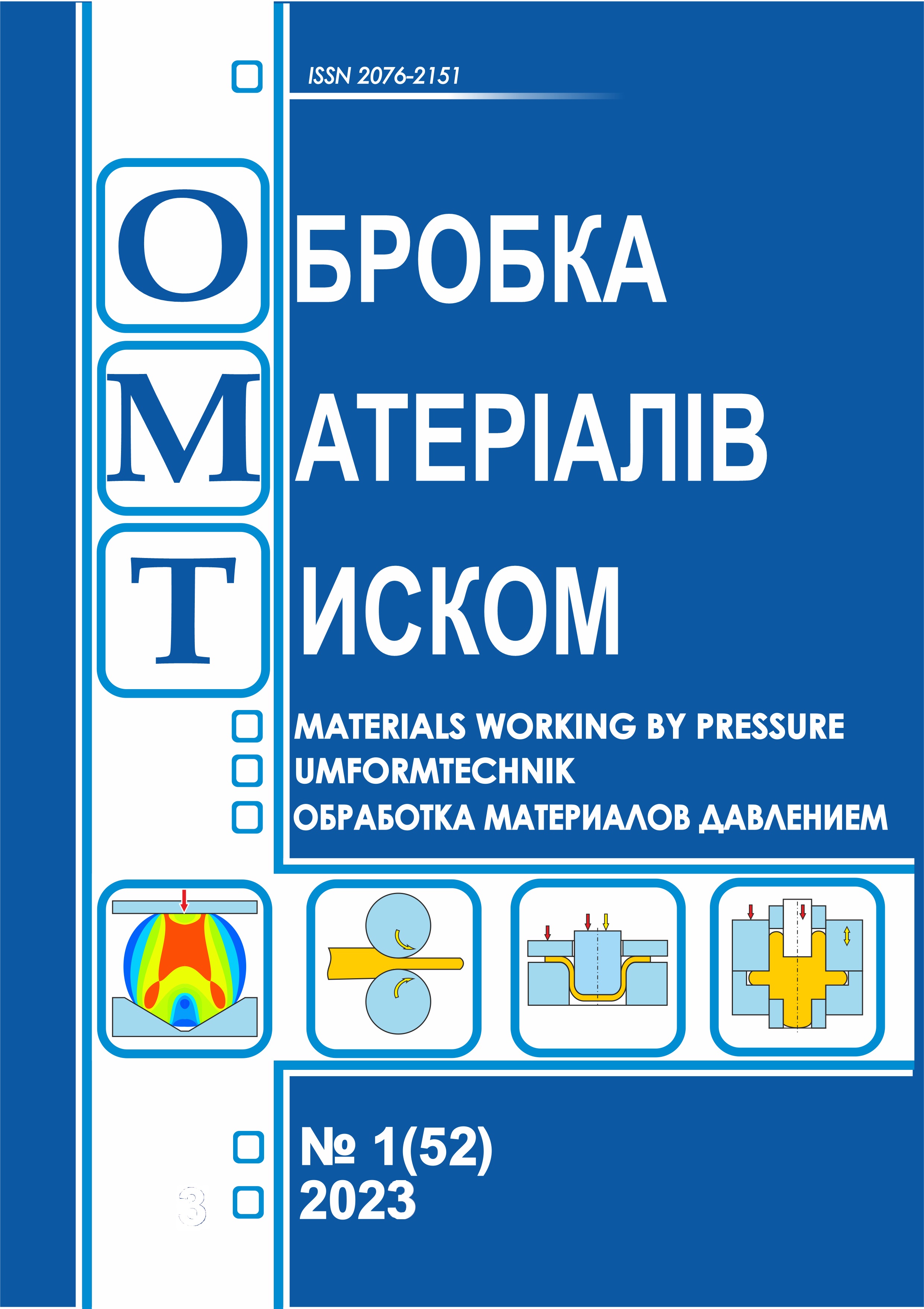Follow-up to the injection of the magnetic mill of the punching punches from the fastener steel for resistance
DOI:
https://doi.org/10.37142/2076-2151/2023-1(52)182Keywords:
magnetic treatment, aggressive puncheon, polarity, magnetic state, firmness, work-hardening, high-speed steel.Abstract
Kindenko М. Follow-up to the injection of the magnetic mill of the punching punches from the fastener steel for resistance
The real work is devoted research of questions, related to research of influence of the magnetic state and polarity of working part of aggressive puncheons from high-speed steel of R6M5 on firmness after magnetic-impulsive treatment, being combination of electromagnetic and thermodynamics methods of management the non-equilibrium structure of matter. Reasons of refuses of instruments are more frequent than all related not to their breakage, but with a loss by them to the primary superficial configuration because of wear, splitting off, crumpling, rastreskivaniya, I.e. in connection with destruction or deformations of superficial skims of metal. High-speed steel, as any solid, possesses the resilient internal field, conditioned the real dislocation structure. With imposition of the magnetic field on material on this own resilient field the resilient field, caused magnetostriction deformation, is laid on. On the whole the result of magnetic treatment is examined as a display of effects of posledeystviya is in materials, being on the scopes of stability of their properties and exposed to influence of the external power field.
It is marked that as a result of influence of the impulsive magnetic field there is a change of fiziko-mechanical properties high-speed steel and instrumental material becomes more homogeneous on a structure. It is set that the wearproofness of the magnetically treated instrument differs from the wear of instrument in initial position. Divergence of mean values of firmness of instrument in the initial state and after magnetic treatment meaningfully, and treatment the impulsive magnetic field substantially influences on.
References
Aliieva L.I., Tahan L.V. Resource-saving Processes of Cold Extrusion: Guide for students. Kramatorsk: DSEA. 2020. 180 p. ISBN 978-966-379-927-8. (in Ukraininan).
Malygin B. V. Magnetic hardening of the tool and machine parts. Moscow: Mechanical engineering. 1989. 112 p. (in Russian).
Volodin V. L., Zuev L. B., Volodin T. V., Gaiduk V. V. Investigation of the influence of magnetic-pulse surface impacts on the performance characteristics of tool steels and tools. Izvestia of higher educational institutions. Ferrous metallurgy. Moscow: 2009, pp. 61–65. (in Russian).
Bershtein M. L., Pustovoit V. N. Heat treatment of steel products in a magnetic field. Moscow: Mechanical engineering. 1987. 256 p. (in Russian).
Kindenko N. I. Magnetostrictive hardening and magnetic dispersion hardening of high-speed steels in pulsed magnetic fields. Scientific Bulletin of DSEA [Online]. Kramatorsk: 2017. No. 2 (23E). pp. 31–35. URL: http://www.dgma.donetsk.ua/science_public/science_vesnik/%E2%84%962(23%D0%95_2017/article/8.pdf. (in Russian).
Kindenko N. I. Wear mechanism and performance of a tool made of high-speed steel and hardened by the HFMF method. Bulletin of DSEA [Online]. Kramtorsk: 2018. No. 2 (44). pp. 120–124. URL: http://www.dgma.donetsk.ua/science_public/ddma/Herald_2(44)_2018/article/24.pdf. (in Russian).
Preobrazhensky A. A. Theory of magnetism, magnetic materials and elements. Moscow: Higher school. 1972. 460 p. (in Russian).
Winter E. K. Magnetic resonance in metals. Moscow: Mir. 1976. 486 p. (in Russian).
Alifanov A.V., Maleronok V.V., Bogdanovich I.A., Lyakh A.A., Milyukova A.M., Tolkacheva O.A. transformations in the surface layers of samples from high-speed steel. Bulletin of Polotsk State University. Series B. Industry. Applied Science. Novopolotsk: 2021. (3). pp. 11–14. (in Russian).
Galey M. T. Study of the influence of the magnetic field on the resistance of a high-speed tool. Machine tools and tools. 1981. No 6. pp. 31–34. (in Russian).
Makedonski BG Treatment of cutting tools with a pulsed magnetic field. Treatment with a pulsed magnetic field. Mater. 4 scientific tech. intl. family on non-traditional technologies AMO'89. Sofia-Gorky: 1989, pp. 30–36. (in Russian).
Kichko Yu. M., Bychkov N. V. Study of the influence of the physical properties of high-speed steels on the optimal strength of the pulsed magnetic field. Optimization of cutting processes of heat- and extra-strong materials. Interuniversity. Scientific Sat. Ufa: 1983, pp. 150–156. (in Russian).
Malygin B.V. Increasing tool life and tooling by magnetic processing. Metallurgist. 1987. No. 10. pp. 46–47. (in Russian).
Loladze T.N. Strength and wear resistance of the cutting tool. Moscow: Mechanical engineering. 1982. 320 p. (in Russian).

